Are you a fellow colder weather adventurer? For people like me who enjoy the great outdoors in all seasons know that proper insulation is crucial. But other features like durability and lightness are equally vital.
After all, who wants stiff, robotic limbs during cold-weather activities or has to shove a sleeping bag-sized coat into a small suitcase or backpack when skiing, hiking, or mountain climbing? Not me!

Fortunately, the innovative design of nano puff and micro puff offers an outer layer of superior warmth without too much volume, heaviness, or stiffness. That makes jackets and hoodies made with nano or micro cozy and durable, yet lightweight.
Patagonia offers plenty of stylish outerwear with micro puff vs. nano puff synthetic insulations. They vary in terms of warmth, materials, and weight ratio.
But what is the difference between nano puff and micro puff? Is one better than the other? More importantly, which is best suited for your needs? Here we will explore the similarities, differences, give a few examples, and help you make an informed decision on which kind of jacket insulation is right for you.
Patagonia Micro Puff
Heavy down jackets with goose feathers that escape their encasing and make you look like you visited a chicken coop are a thing of the past! You can also say goodbye to clumpy synthetics.
Patagonia has provided high-quality, durable outdoor activity products with innovative design and sustainable, eco-conscious practices. Designers, developers, and research experts at Patagonia worked tirelessly to solve the issue of providing quality insulation that is durable and weather-resistant while remaining extremely light and compact.
Patagonia micro puff products like jackets and hoodies use PlumaFill, a synthetic insulation that mimics the warmth of natural down. It took Patagonia’s research and development team seven years to create PlumaFill and over a decade to transform the insulation technology into the perfect piece of modern outerwear.
Best Micro Puff Outerwear Picks
- Patagonia Men’s Micro Puff Jacket
- Patagonia Women’s Micro Puff Jacket
- Patagonia Men’s Micro Puff Hoody
- Patagonia Women’s Micro Puff Hoody
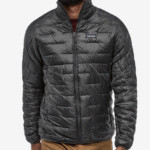
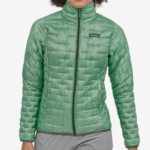
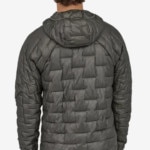

Tech Specs
- FABRIC TECH:
Innovative, lightweight PlumaFill synthetic insulation made from recycled polyester (65 g/.14 lbs) - SHELL AND LINING:
0.7-oz (19 g), 10-denier
Windproof and water-resistant Ultralight Pertex® Quantum 100% nylon DWR-treated ripstop shell. - SIZES:
Available in standard Men’s sizes XS-XXL and Women’s sizes XXS-XL - WEIGHT (JACKET):
Women’s Jacket 207 g (7.3-oz), Men’s Jacket 235 g (8.3-oz) - WEIGHT (HOODY):
Women’s Hoody 227 g (8-oz), Men’s Hoody 264 g (9.3-oz) - PRODUCT CERTIFICATION:
Fabric is bluesign® approved, and Fair Trade™ Certified sewn - OTHER FEATURES:
Adjustable elastic cuffs and hem seal in warmth
Center-front zipper with storm flaps
Two zippered front pockets and two internal pockets
Hoody models feature helmet-compatible hoods
Pros
Cons
Patagonia Nano Puff
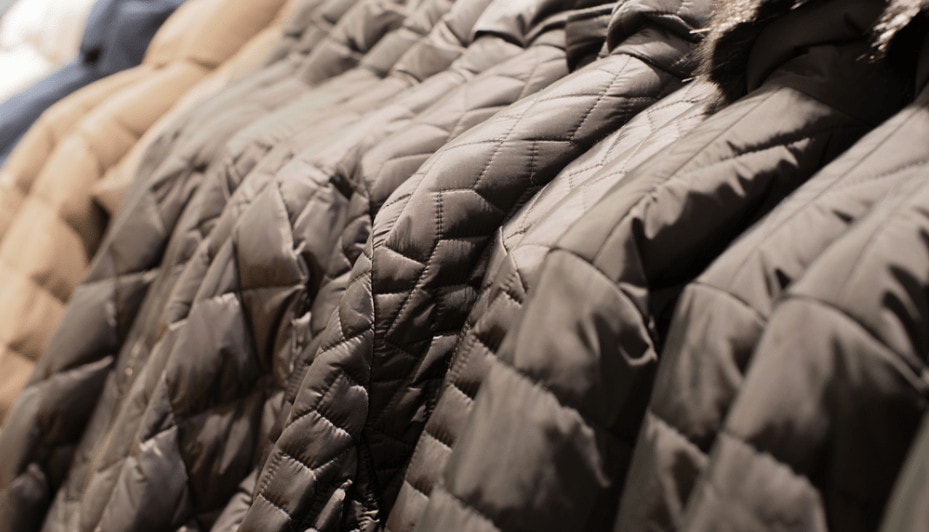
Patagonia’s nano puff outerwear arrived in 2010. Over a decade later, the jackets are still considered iconic and essential clothing options for outdoors adventurers and cooler weather fashionistas alike.
The driving force behind the nano puff synthetic jacket’s continuous popularity is a killer combination of warmth, versatility, compactness, and stylish design.
The Patagonia nano puff can fold into its pocket, so it’s great for easy storage and saving space while traveling. The jackets and other outerwear are stylish enough to wear on the streets or in the mountains.
And while it might not provide enough heat on its own to keep you cozy atop Mount Everest, the lightweight jacket can serve as a mid-layer between a simple tee-shirt and heavier coat that will provide warmth without adding too much bulk.
Another exciting feature of the nano puff outerwear line is its kindness to the environment. Patagonia utilizes recycled materials in its clothing and sports gear.
Nano puff jackets use PrimaLoft® Gold Insulation Eco polyester made from recycled content. Currently, the shell, lining, and insulation use 100% recycled polyester.
Best Nano Puff Outerwear Picks
- Patagonia Nano Puff Men’s Hoody
- Patagonia Nano Puff Women’s Hoody
- Patagonia Nano Puff Men’s Vest
- Patagonia Nano Puff Women’s Vest


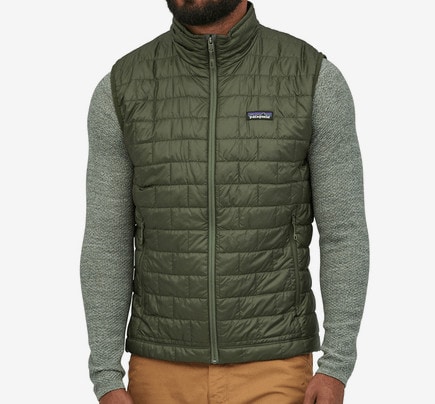
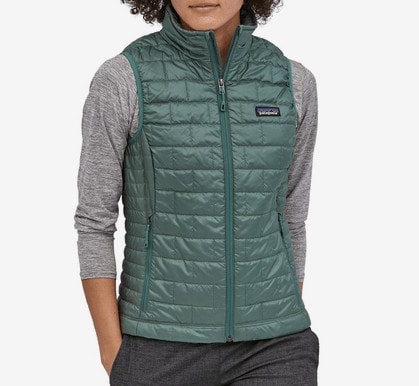
Tech Specs
- FABRIC:
The synthetic insulation is 60-g of PrimaLoft® Gold Insulation Eco polyester using 100% post-consumer recycled materials with P.U.R.E.™ to reduce emissions. - SHELL AND LINING:
Lightweight 100% recycled polyester DWR-treated ripstop shell. Shell: 1.4-oz, 20-denier. The lining uses 100% post-consumer recycled materials and a PFC-free DWR weather-resistant coating. Lining: 1.3-oz 22-denier. - SIZES:
Available in standard Men’s sizes XS-XXL and Women’s sizes XXS-XL - WEIGHT (VEST):
Women’s Vest 207-g (7.3-oz), Men’s Vest 227 g (8 oz) - WEIGHT (HOODY):
Women’s Hoody 306-g (10.8-oz), Men’s Hoody 363-g (12.8-oz) - PRODUCT CERTIFICATION:
Fabric is bluesign® approved, and Fair Trade™ Certified sewn - OTHER FEATURES:
Adjustable elastic cuffs and hem seal in warmth
Center-front zipper with storm flaps
Two zippered front pockets and one internal pocket
Horizontal quilting pattern
Hoody models feature helmet-compatible hoods
Pros
Cons
Features Face-to-Face
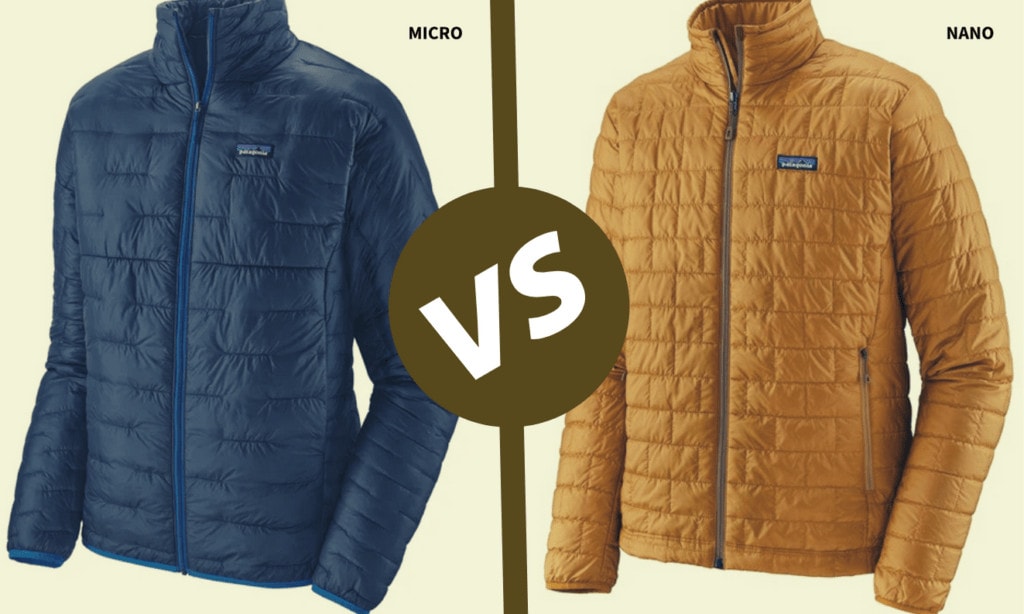
Both Patagonia jackets are fantastic, but they are so similar. So what’s the difference and which one is better?
It’s time for a Patagonia micro puff vs. nano puff face off! May the best jacket win!
1. Warmth
Unless it’s purely for style, the likely reason you’re choosing a Patagonia micro or nano puff jacket is to stay warm during cold weather outdoor activities. They offer excellent weatherproof protection that keeps you warm even when wet.
Both jackets have different types of insulation and volume amounts. The micro puff insulation uses 65-g of PlumaFilll made from 100% polyester that is notably warmer than other synthetic insulation. In contrast, nano puff jackets use 60-g of PrimaLoft® Gold Insulation Eco.
The insulation material used in micro puff retains more heat, there is more of it, and it has a higher fill power (FP) rating at its fully expanded volume. However, the nano puff jackets have a thicker outer layer, so it’s a close call.
Winner in Warmth: Micro Puff
A tip: It’s important to note that while both jackets are cozy and warm, neither material is very breathable, so on a moderately cold day, you will be able to get away with just a thin under-layer. In more extreme weather, nano or micro puff jackets work well as a mid-layer, but not if you plan to sweat a lot because they will trap the heat.
2. Compactness and Compressibility
Compared to the sleeping bag coats and most other synthetic insulation jackets, both the micro puff and the nano puff are revolutionary in terms of compressibility. Both of them can fold up into their own pockets! How’s that for convenience and traveling light?
Now to nitpick. If only one jacket were on the market, it would be the superior product. But, in the game of micro versus nano, the micro puff reigns supreme for its compactness and compressibility.
The Men’s Hoody nano jacket weighs 363-g (12.8-oz), and the Men’s Hoody micro jacket weighs 264 g (9.3-oz). As for the shell and lining, for the micro puff, both are 0.7-oz, 10-denier. The nano puff shell is 1.4-oz, 20-denier, and its lining is 1.3-oz 22-denier, regardless if you choose a Hoody or a vest.
Both are very lightweight, but the micro jacket is in the featherweight division of this boxing ring.
Winner in Compactness and Compressibility: Micro Puff
3. Durability
In some cases, lighter isn’t always better. What the micro puff loses in weight and bulk, it sacrifices in durability and resilience against damage.
Patagonia micro puff jackets use the thinnest material possible, making them light as a feather but almost as delicate.
The company’s products are well-made, and this shouldn’t be a concern as if the jacket were a silk shirt, but the shell fabric on the nano puff is tougher and offers more protection.
Winner in Durability: Nano Puff
4. Design and Style
Patagonia’s micro puff and nano puff are innovative and revolutionary products in terms of their overall design. But what about style?
The micro puff stands out for being incredibly lightweight and compressible, thanks to using Patagonia’s thinnest material available. But its lightness and delicacy give the jackets a trash bag chic appearance, whereas the nano puff jackets and vests have a more chic, modern, and classic style.
However, style is a matter of personal taste. One person’s trash bag is another’s treasure! The micro puff features an innovative quilting pattern, while the nano has horizontal stitching, which is more water-resistant.
Winner in Design and Style: Nano Puff
The Winner
It’s a tie! In terms of warmth, compactness, and compressibility, Patagonia micro puff reigns supreme. But when it comes to design, style, and durability, the nano puff comes out on top. The only way to break the tie and declare a victor is to examine their standout features further.
Standout Features

- Sustainable, recycled, eco-friendly materials
- The shell, lining, and insulation material for Patagonia nano puff outerwear use 100% recycled materials. The PrimaLoft® Gold Insulation Eco polyester uses 100% post-consumer recycled materials with P.U.R.E.™ technology to reduce emissions.
- For the micro puff, only the PlumaFill insulation is 100% recycled polyester.
- Pockets and storage ability
- Both nano puff and micro puff jackets can fold up into their interior pockets to the size of a small pillow.
- The nano jackets have three pockets total, while the micro puff outerwear has four, with one additional internal pocket.
- Waterproof and warm
- Both nano puff and micro puff jackets retain warmth when wet and are treated with DWR (durable water repellent) finish.
- Micro puff jackets passed Patagonia’s punishing “Killer Wash” test with almost no loss in loft.
- Both Patagonia outerwear products have storm flap zippers and adjustable drawcords to seal in heat.
Conclusion

When it comes to Patagonia micro vs. nano puff, since the two are so similar, it’s a tough call and mostly a matter of preference. Both are outstanding products that revolutionized the outerwear industry.
Use Micro Puff if:
- Lightness, compactness, and compressibility are essential.
- Cozy warmth and protection from wetness are important.
Use Nano Puff if:
- You need a more durable jacket that’s still lightweight.
- Concern for eco-friendly clothing is a top priority.
Whichever you choose, be confident that Patagonia’s nano and micro puff jackets continue to stand out as versatile, lightweight, compact, high-quality, superior-performance clothing.
FAQ
What’s the best winter jacket?
The best winter jackets are warm, weatherproof, water-resistant, and lightweight. The thickness of the shell, lining, and insulation depends on the temperature and activities.
Do Patagonia jackets shrink?
No, if you follow the care instructions. Machine wash on a gentle cycle and tumble dry low with a tennis ball or two to retain fluffiness.
Why is Patagonia so popular?
Patagonia is known for innovative high-tech designs, quality, durability, and ethical, sustainable practices.
You may also like: Check out These 10 Patagonia Like Brands You Shouldn’t Miss







